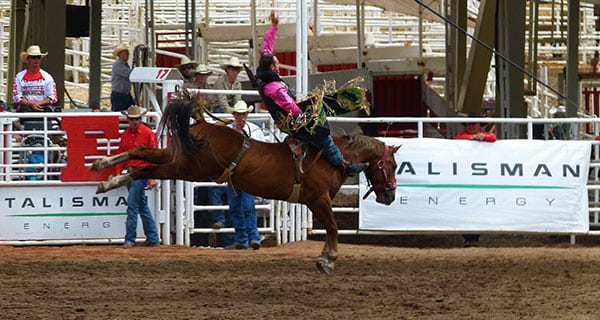 As a member of a family who never missed a Calgary Stampede in 30 years of Calgary residency, I was made incredibly happy by Facebook pal George Brookman’s recent post.
As a member of a family who never missed a Calgary Stampede in 30 years of Calgary residency, I was made incredibly happy by Facebook pal George Brookman’s recent post.
His announcement was simple, and direct: “A wonderful representative of the Indigenous people, Cieran Starlight will be the last ‘Indian Princess’ to represent the ‘Indian Village.’ Traditions are hard to give up for everyone involved, but the new name ‘Elbow River Camp’ will come to be just as important and cherished as the village has always been.”
The roots of this change run deep. One could argue that Treaty 7, signed in 1877, is the formal starting point in the relationship between the Indigenous people of what is now southern Alberta, the Siksika, Kainai, Piikani, Tsuut’ina and Stoney-Nakoda, and the settlers who flooded in from points east and south.
A signal indication of the treaty’s importance occurs every Stampede parade when mounted Treaty 7 flag bearers display their flag along with the Union Jack.
Treaty 7 was signed by Chief Crowfoot and the headmen of Treaty 7, along with two representatives of the Crown, representing “The Great White Mother,” Queen Victoria. These were the David Laird, lieutenant- governor of the Northwest Territories, and Lt.-Col. James Macleod, commissioner of the North West Mounted Police.
Thereafter, when the Treaty 7 flag is paraded on occasions that involve the settlers and their institutions, it marches side by side with the Great White Mother’s flag. This display is truly nation to nation in historic terms.
Our children share a special memory of the Stampede display of the Treaty 7 colours. In 1987, we were early risers to get front-row seats on the Ninth Avenue parade route. I remember my son, then just five years old, and my daughter at two, clutching my hands as we walked through the July heat to find a small space curbside. We were about half an hour early and had small camping chairs for the kids to sit on.
I was eager too, having recently joined the board of the Calgary Indian Friendship Centre. I was looking forward to the Treaty 7 nations’ floats, which always came at the start of the parade.
Soon we could hear the distant notes of the Calgary Stampede Showband and the approaching clip-clop of shod horses. Sure enough, the Treaty 7 chiefs were approaching, dressed in full plains regalia, complete with magnificent headdresses.
The closest rider to our family, holding the Treaty 7 flag, was soon abreast of us. As he passed, he looked down and said, “Hi Mike!” It was my friendship centre board mate Andrew Bear Robe.
The language of Indigenous nationhood was still somewhat experimental in 1987. The newspapers still talked of ‘cowboys and Indians,’ and when you went down to the grounds, it always involved a visit to the Indian Village.
The Indian Princess was a fixture in the Stampede royalty, but she wasn’t one of the Stampede Princesses or the Stampede Queen. That title always went to beautiful settler gals, with the requisite equestrian training and models’ poise. These juxtapositions were noticeable and, during Stampede, very in your face if you stopped to think about their symbolism.
But somehow it was Stampede – school was out; families were on vacation. Everyone was intent on having fun.
The famous Stampede spirit covered over problems more evident in society during the cold winter months and false springs that Calgarians know all too well. However, that engaging community spirit was magic to us as new Calgarians from the coast.
Vancouver, our place of origin, had nothing to compare. Our old city traded on the Pacific National Exhibition, but there was no comparable spirit of volunteerism. And it certainly made little if any reference to the adjacent Coast Salish communities of Musqueam, Tsleil-Waututh or Squamish. The PNE was basically an agricultural fair along with Playland, a collection of circus-like midway attractions.
Stampede seemed a much truer celebration of the home town that people wanted. It modelled the best of us to us – and, over the years, to millions of others.
So when I read George’s Facebook announcement, it evoked all those old Stampede feelings from days long past. And it showed that Calgarians have now more fully embraced the language and spirit of reconciliation with the neighbouring Indigenous nations, our founding partners in Treaty 7.
The old Stampede spirit is still at work.
Troy Media columnist Mike Robinson has been CEO of three Canadian NGOs: the Arctic Institute of North America, the Glenbow Museum and the Bill Reid Gallery.
The views, opinions and positions expressed by columnists and contributors are the author’s alone. They do not inherently or expressly reflect the views, opinions and/or positions of our publication.
This site is Powered by Troy Media Digital Solutions


